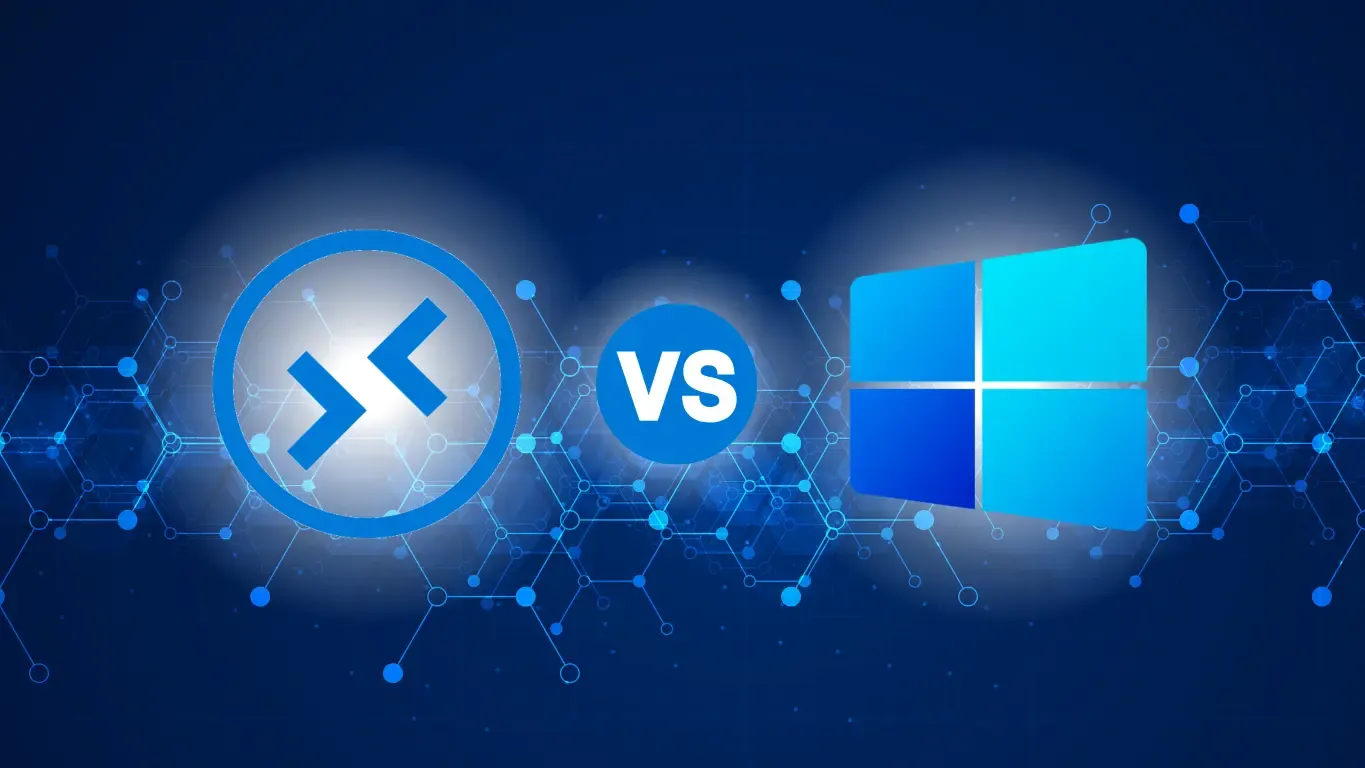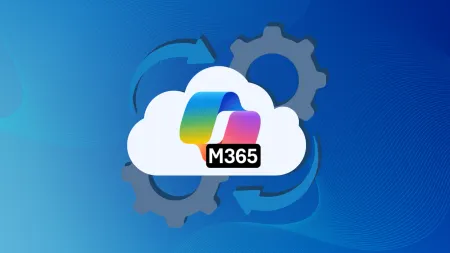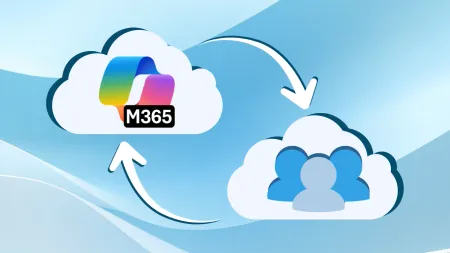AVD vs W365 in GCC High Reducing Your CMMC Scope and Simplifying Compliance
Comparing AVD vs W365 for GCC High? Learn how each can reduce your CMMC assessment scope and simplify security and compliance management in government environments.

As businesses increasingly work from a decentralized setup, contractors in the United States Defense Industrial Base must find modern solutions to streamline their operations, protect private data, and maintain compliance with current federal regulations. Desktop-as-a-Service (DaaS) architecture has emerged as the most innovative and efficient model for businesses to use as the backbone for remote work, thanks to its scalability, affordable price point, and consistently high performance. The importance of these services is indicative of the projected growth of the virtual desktop industry over the next decade.
Two popular cloud-based solutions in this space are Windows 365 and Azure Virtual Desktop (AVD). While both platforms bear some similarities to each other, there are notable differences in their feature sets and scope that make each service better in certain environments. In this article, we will go through the characteristics of AVD and Windows 365, the plus points of each platform, and the ideal scenarios for using either service.
Quick Overview: AVD and Windows 365
Azure Virtual Desktop is an app and desktop virtualization service built on Azure architecture to provide flexibility and scalability to contractors operating on the platform. One of AVD’s signature features is the exclusive ability to set up multi-sessions in Windows 10 Enterprise and Windows 11, reducing the amount of resources needed to run virtual machines and operating systems without impacting the user experience. This and other attributes enable organizations to bring existing Windows Server apps and Remote Desktop Services (RDS) to any computer on command.
Windows 365 is a simpler, persistent solution that seeks to optimize the user experience. The service automatically creates a new cloud PC (Windows Virtual Machine) for each user and assigns it to them as a dedicated Windows device. Windows 365 also offers fixed per-user pricing, support for Windows 10 and 11 desktops, and the productivity benefits of Microsoft 365. It is available in two editions that cater to separate customer needs and preferences: Windows 365 Business is designed for smaller businesses, while Windows 365 Enterprise is made for larger conglomerates.
AVD and Windows 365 are both available in GCC High, making each platform a viable option for contractors and related companies who must adhere to stringent federal regulations.
Benefits of Using AVD vs W365 in GCC High
1. Scope Reduction for CMMC Assessments
Earning a Cybersecurity Maturity Model Certification (CMMC) is vital for any contractor to validate their ability to properly handle controlled unclassified information (CUI). The first step in any CMMC assessment process is to scope the impact of CMMC on your company. This gives you details on how the CMMC compliance guidelines will influence your team’s internal operations. Scope reduction remains important after you earn the CMMC certification, as the certification must be renewed every three years. You may also undergo a delta assessment if any substantial changes are made to your CUI environment.
Implementing AVD or Windows 365 enables organizations to utilize boundary-based scoping, reducing the number of systems in the scope of any CMMC assessor. Both platforms help to isolate and contain environments where CUI is accessed to center the assessment process on relevant infrastructure.
2. Simplified Security and Management
Zero Trust architecture (ZTA) is the modern solution to restrict access to data centers and minimize the threat of potential cyber attacks. AVD and Windows 365 enable contractors to develop this strategy by streamlining desktop management and providing better security tools.
AVD comes equipped with Entra ID Directory Conditional Access to implement specific access rules for certain people or devices that help to prevent unauthorized entry into your systems. Management tools such as the Azure portal, PowerShell, and REST APIs make it easier to oversee host pools and applications. Windows 365 stores all workstations and data on Microsoft’s secure cloud through Microsoft Intune, reducing the risk of data loss or theft on end-user devices. Microsoft Defender for Endpoint is another security measure to prevent, monitor, and combat cyber threats to enterprise networks.
3. FedRAMP and GCC High Alignment
The Federal Risk and Authorization Management Program (FedRAMP) was created to provide a standardized process for assessing and monitoring the ability of cloud computing services to protect federal data. There are two separate levels within the initiative: FedRAMP Moderate, which is recommended for organizations that handle non-sensitive information, and FedRAMP High, which is suited for companies hosting CUI. Both AVD and Windows 365 can help prove that your company has the cybersecurity tools to manage highly valued data.
Each platform is eligible for use in GCC High, making it easier to demonstrate compliance across all departments. They are backed by Microsoft’s government cloud compliance stack, which provides five levels of data security and compliance support to protect contractors and their partners while adhering to strict compliance requirements.
AVD vs W365: Which One Should You Use in GCC High?
Azure Virtual Desktop is best for organizations that require multi-session desktops to support task-based roles. Flexibility is at the center of all of AVD’s best features. The platform gives you full configuration and management control to serve diverse workloads and needs. AVD can also raise or lower its capacity depending on the time of day or in response to other organizational changes, providing a scalable environment and managing your resources.
By contrast, the main appeal of Windows 365 lies in its simplicity. Deploying the platform is a simple turn-key solution, and per-user pricing is pleasingly predictable. Onboarding is also expedited as no virtual desktop infrastructure skills or experience are needed to incorporate Windows 365 into your operations. If you’re working with a smaller team or don’t have heavy IT overhead, then the scalability of Windows 365 is hard to beat.
Common Scenarios and Use Cases
The most common use cases for AVD in GCC High are in IT-intensive environments where that signature flexibility can be leveraged, and volume is high enough to need concurrent sessions. This is apparent in many industries where employees or users can’t be assumed to have the same level of hardware or software resources. AVD is also implemented in call and contact centers to maintain compliance and productivity standards.
Windows 365 is made for contractors who need access to CUI for their work, but don’t require a full VDI setup. Companies collaborating with third-party consultants or contractors can connect to the cloud with a license and make a protected entrance into their system. Another scenario is with newly acquired or merged employees to help them connect with their own devices in just a few hours.
How to Get Started with AVD or W365 in GCC High
Finding the right DaaS solution for your organization can be a complicated process. Here is some advice you can follow to ensure that you pick the best cybersecurity platform for your needs:
-
Assess your current CUI boundary and IT management capabilities – Evaluating the status of your company is important to determine the scalability and depth of features you’ll need from any DaaS provider.
-
Confirm that you have everything in place to support CMMC readiness – Earning official CMMC certification requires meeting certain requirements for each CMMC level. Senior management must ensure that they have the right policies, monitoring systems, and documentation to confirm that their establishment deserves a CMMC certification.
-
Work with a Microsoft partner to deploy AVD or Windows 365 in GCC High – Collaborating with a partner who is passionate about and knowledgeable about DaaS solutions can help you deploy AVD or Windows 365 with little concern for mistakes.
Conclusion
DaaS solutions can provide access to data and applications from any device without sacrificing security. AVD and Windows 365 are both worthwhile platforms that can advance your business goals depending on a number of factors. Agile IT assists contractors in making the best choices for their situation and reaching the standards of each CMMC level through programs such as AgileThrive and AgileDefend. Need help choosing between AVD and W365 for your CMMC environment? Contact Agile IT today.





